- Submissions

Full Text
Advancements in Civil Engineering & Technology
Analytic Evaluation of the Case Studies of Rivers and Reservoirs to Review Relative Impacts of Different Pollution Sources on Catchment Level Stream Ecosystems
Hafiz Muhammad Nadir*
PhD Researcher, Civil Engineering Group, School of Built Environment & Engineering, Leeds Beckett University, Civic Quarter Northern Terrace Leeds, LS2 8AG, UK
*Corresponding author:Hafiz Muhammad Nadir, PhD Researcher, Civil Engineering Group, School of Built Environment & Engineering, Leeds Beckett University, Civic Quarter Northern Terrace Leeds, LS2 8AG, UK
Submission: June 26, 2023;Published: July 18, 2023

ISSN: 2639-0574 Volume5 Issue5
Abstract
The climatic variations, global warming, greenhouse gas emissions, non-regulated extraction of water from main sources/ground, increased use of fertilisers/slurry and ingress of chemicals with surface runoff all impact water quality/quantity. The pharmaceutical chemicals/antibiotics/drugs that are excreted by human beings and remain untreated in the treatment process are observed exceeding limits in the water bodies, causing further passive degradation of biodiversity and fatal intake by aqua life/animals and impacting the end users (human beings). This study has elucidated various case studies of rivers/ reservoirs to assess the pollution sources affecting the water quality on catchment level ecosystems. The study reviewed the case studies of ten rivers/reservoirs and wastewater treatment plants in developing/ developed countries and observed that the unregulated/unsafe adjacent land uses and untreated waste disposal in the streams are the main factors causing contamination in the water bodies. Untreated disposal of waste/sewage/effluents in the streams from domestic/commercial/agricultural fields is uncontrollably increasing, causing genetic variations, reduced abundance and depletion of growers and primary/ secondary consumers and affecting the health of the tertiary consumers in the ecosystems. The phenomenon is more pronounced for the drinking water reservoirs as they directly impact the health and well-being of the consumers, along with the increased cost of treatment of contaminated water. Catchment-sensitive farming and advanced filtration/treatment of water have been introduced as effective mechanisms to control this menace of pollution/contamination but are still not fully successful. The people’s awareness and public/private partnership in implementing the best/sustainable catchment level management strategies must be implemented to maintain the excellent quality of water from headwater to downstream.
Keywords:Water contamination; Pollution factors; Adjacent land uses; Catchment-sensitive farming; Sustainable river basin management
Introduction
The growth of population, development of cities and urbanisation along water channels is a historical reality due to the importance of water streams in human life as a source of drinking water, food, transportation means, recreational activities and waterfront living [1]. The human desire to live along water streams has resulted in enormous anthropogenic impacts on stream ecosystems/biodiversity [2]. The pollution from diverse sources impacts the genetic level to the colony formation level of the stream ecosystem and biodiversity is decreasing/depleting rapidly [3]. The streams are the hub of aqua life, but due to anthropogenic activities, these are the most affected and endangered sources of extinction of the aqua ecosystem [1]. Using water streams for irrigation, transportation, power production, drinking and recreational facilities has resulted in heavily modified water streams that have become irreversible [3]. As per the opinion of different researchers, there have been various/multiple stresses of damage/ deterioration of the ecosystem due to river channelisation, treated bed/banks, deforestation, overfishing/ growth of alien species, damming/barraging, mixing of pollutants like heavy metals, pesticides, insecticides, fertilisers, industrial chemicals, road pollutants, eutrophication, micro-pollutants from wastewater treatment plants (WWTP) [2,4-7]. The European Union water framework directive bound its member states to enhance the river quality to good status by 2015. Still, almost 40-90% of water streams have failed in different countries, and a new deadline of 2027 has now been set to reach this uphill target [8,9]. In this study, various sources of pollution have been elaborated to elucidate their impact on the river ecosystem, as depicted in Figure 1 [7].
Figure 1:Pollution source in water streams [7].
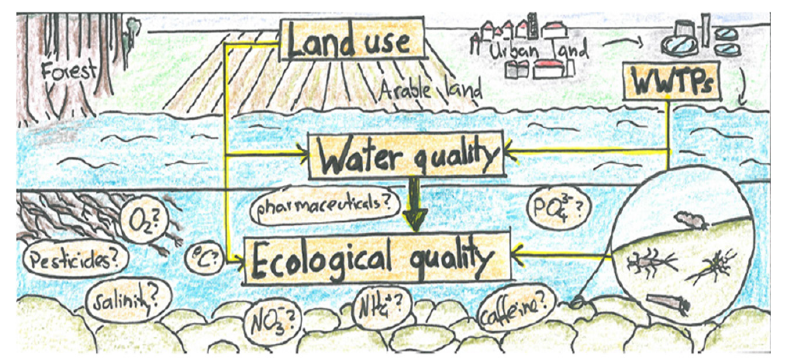
UK Groundwater Forum UKGWF (2016) on WFD explains the elements of water input and output and water pollutants/ toxins sources in a 3-D layout, as shown in Figure 2 [10]. Water input is precipitation to a river basin, a portion of which goes to groundwater, balance goes as surface runoff into the rivers, evaporation and evapotranspiration. The main pollutants and toxins come from sediments/suspended solids (SS) mixed with precipitation water, urban runoff, industrial waste, leakage in sewerage systems and nutrients/ chemicals from farms/ agriculture such as pesticides, fertilisers, insecticides and manure. Water for domestic use is stored in reservoirs, impacting the quality/quantity of water in open streams and directly impacting aqua life by disturbing the water cycle. Therefore, suitable catchment management practices are required to maintain the water cycle (precipitation, evaporation, transpiration, evapotranspiration, surface runoff) with minimum disturbance, as shown in Figure 3 [11].
Figure 2:Source of Pollution affecting river ecosystem [10].
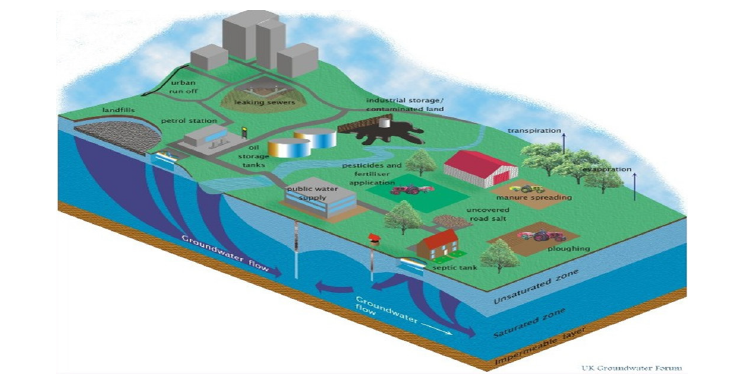
Figure 3:Water Cycle [11].

Sources of Contamination/Pollution in Water Streams
Pollution from agriculture/Farms land and its impact on river ecosystem
The water streams face anthropogenic concentrations of nutrients and suspended sediments (SS) due to the increased use of fertilisers/manure/chemicals [12]. Surface runoff from arable/ farmlands produces up to 75% of SS [13], 25% of phosphorus and 60% of nitrate inputs to rivers [14]. Modified riparian vegetation, land use and advanced agriculture/farming have affected water quality and aquatic communities, decreased diversity and shifts in the relative abundance of aquatic invertebrates [15]. In contrast, sites of good riparian quality present higher densities of scrapers, predators and collector-gatherers invertebrates [16]. Figure 4 shows how the surrounding land use impacts the river ecosystem and biodiversity across its length from headwater to tail (downstream) [17]. More shredders and collectors and lesser grazers invertebrates are found at the origin, but as we go downstream, shredders decrease and grazers increase; only collector’s species survive, and the rest of the species disappear with the increased contamination/ pollution in the channel. Trout and smallmouth fish are present in clean water, which disappears with increased pollution/contaminated water downstream and a small quantity of catfish family is found downstream. Similarly, course particulate matter/vegetation converts into fine particulate foliage in decreased amounts as we go downstream due to increased impacts of pollutants/land use [17]. A detailed review and analysis have been conducted in this paper to elucidate the specific pollutants and contaminants entering water streams from various sources, the effectiveness of catchment-sensitive farming and advanced filtration/treatment methods in controlling water contamination and concluding the long-term consequences of water contamination on human health and the environment.
Figure 4:Impact of agriculture/land use/surface runoff on River Ecosystem [17].

Analysis and Discussion on River and Reservoirs’ Case Studies
Case study: Nui Coc reservoir in Vietnam
Quynh Le et al. [18] conducted a nitrogen and phosphorus (N & P) budget of the Nui Coc reservoir in Vietnam to determine the degree of anthropogenic N & P cycles. The results showed excess outputs from the agricultural/farm soil system, indicating the excess fertiliser use in the catchment. 50% nitrogen and 51% phosphorus fluxes from agricultural and forest soils were observed. About 66% of the annual total nitrogen and 79% of the total yearly phosphorus inputs to the ecosystem were deposited/eliminated in the reservoir. These authors noted that in the reservoir, cyanobacteria were the major contributor to phytoplankton composition with a relative abundance that ranged from 27% to 84%, which has resulted in a potential threat of diseases to 200,000 people and animals and a 74% reduction in fish, 70% reduction in biodiversity [18].
Case study: Study of land uses impacts on 21 sites in catchment areas in the Chile river
Fierro et al. [19] studied 21 sites in river catchment areas in Chile with different land uses of pristine/ native/exotic forests and agricultural/farms land. Riparian vegetation quality and biodiversity were highest in pristine forests and the worst of farm catchments. Water quality and macroinvertebrate assemblages significantly varied across land-use areas, with the worst in forest plantations and agricultural/farms land having high nutrient concentrations, conductivity, suspended solids and apparent colour. Macroinvertebrate assemblage diversity was lowest for agricultural/farmland and exotic forest plantation catchments, with notable non-insect representation. It shows the severe impacts of pollutants and nutrients on the river ecosystem by agriculture/ farms [19].
Case study river Wharfe Leeds, UK: Impact of adjacent land uses on river ecosystem
The abundance and richness of biodiversity and physiochemical properties of water in a stretch of a river have been the main indices to check the water quality and impacts on the river ecosystem [20]. However, all these indexes show varying results depending upon the land use type, rock formation/ strata, urbanisation, sources of pollution and infrastructure adjacent to each site [21]. Nadir and Carrivick [22], in their study on River Wharfe at five sites, suggest that there is always a localised effect as the river flows from its headwater to downstream through human habitat/infrastructures in different towns. Water quality continues to deplete, and biodiversity in the ecosystem continues to decrease with an increase in dissolved salts/minerals, ionisation and pollution at various locations. The impact of adjacent land use at five sites on river Wharfe’s water quality revealed that the river exhibited a superior water quality at the headwater (the origination point). Still, the quality keeps decreasing as the water flows through the length of the catchment in the different geographical landscapes, various land uses and urbanisation. It was observed that the chemical contamination increased, and biodiversity (macroinvertebrates) abundance/ richness (counting) decreased from headwater to downstream (site 1 to site 5), attributed to the entry of contaminants/ pollutants/ nutrients from different land uses/ resources as shown in Figures 5 & 6 [22].
Figure 5:Decreasing Trend for Richness & Abundance of Macroinvertebrates from Site 1 - Site 5 [22].
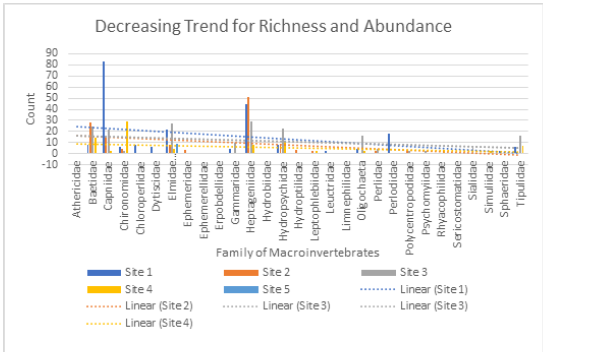
Figure 6:Increasing trend of chemicals’ quantities/ parameters - River Wharfe site 1 to site 5 [22].
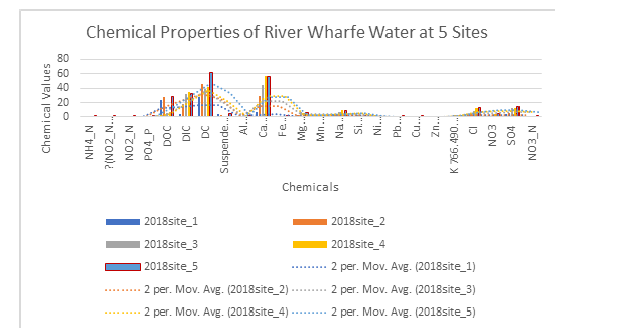
Case study of river Mississippi, USA: Effects of heavy modifications/ structures, deforestation and sediment transport on river ecosystem
Mississippi River is the biggest river in the USA, with a length of 3700km affecting 32 states in the USA, starting from Lake Itasca and falling in the Gulf of Mexico [23]. Eight thousand engineering structures, including dams/dykes, 2000 flood levees, bank/ beds lining, channelisation and barraging systems, have been constructed since the 1700s to convert the naturally meandering river into a beautiful channel, as shown in Figure 7 [24]. The five deep-water ports on the lower Mississippi River are generating multi-billion USD [25]. The river was straightening for efficient transportation but has reduced 240km length, thus increasing the flood speed [25]. Deforestation, land infertility and reduced water table/marshy areas are caused by the reduction of floodplain width from tens of km to a small channel [26]. Climate changes due to land use change/damming result in extreme rain events. Reduced sediment movements due to dams cause a 10-13% loss of sediments [27]. Due to concrete-lined channels and structures, fish species, algae, and invertebrates are decreasing [28]. They have affected the ecosystem by reducing the population of Algy, grazers, predators and fish due to reduced nutrient recycling, decomposition, biomass conversion and reproduction. All environmental studies/ rehabilitation/ restoration efforts have remained futile to prevent the modifications in River Mississippi fully resulting in the estuary area of Mississippi in the Gulf of Mexico has become a dead zone with 100% fish and aqua life decay, disturbing the ecosystem entirely [29].
Figure 7:Mississippi River modifications by USA [24].
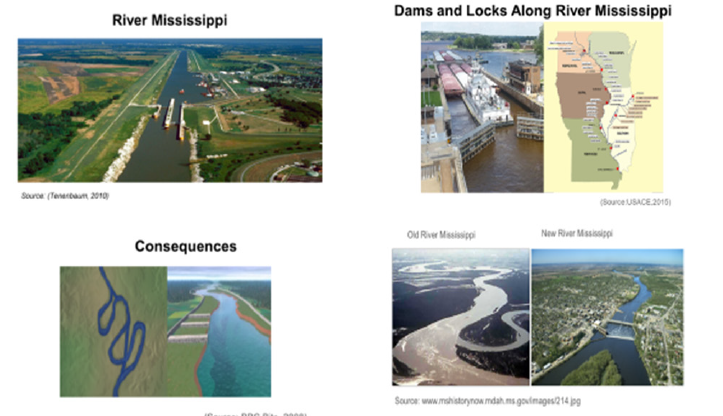
Case study-effects of industrial waste, micro-pollutants and pharmaceuticals chemicals from wastewater treatment plants (WWTP)
All organic/inorganic/chemical compounds produced by anthropogenic activities enter the river ecosystem daily due to human waste. It gives rise to potential damage to aquatic life [4]. These emerging compounds with no regulated limits are other than the forty-five priority substances EU WFD listed [30]. These include substances used in industry and domestic life, like pharmaceuticals, personal care products, hormones, industrial chemicals/byproducts and transformation products [31]. The studies conducted on the quality testing of river water after receiving treated water from treatment plants observed that these emerging pollutants have diverse impacts on the river ecosystem, causing modified genetics/molecular structure and total loss of species [32]. A stressor-specific, traits-based metric “SPEAR” index was developed for pesticides, general organic toxicants [33] and salinity in addition to the commonly used taxonomic richness and diversity metrics like Shannon or Margalef diversity indices [34].
Case study-Iberian River basins: Temporal/ seasonal impacts of pesticides, fertilisers, plastics, metals and industrial waste on fish, algae and invertebrates
Kuzmanovic et al. [31], in their studies on four Iberian River basins (Llobregat, Ebro, Jucar and Guadalquivir) assessed the ecotoxicological risk of chemical pollution by measuring more than 200 emerging and priority compounds at 77 sampling sites along four river basins studied. Chemicals/organic compounds/ metals/ nutrients from industry/ household/ WWTP/ agriculture were observed in 2010-11. River Ebro and Jucar were more than 75% polluted and Llobregat and Guadalquivir were 25-50% contaminated, as shown in Figure 8. Their impact on aquatic ecosystems like fish, algae and invertebrates was observed, as shown in Figure 9. The maximum effect of organic compounds/ chemicals was found on fish/ invertebrates and the impact of metals was observed maximum on Algae. The Taxonomic Unit TU SPEAR of organic chemicals and pesticides showed genetic variations in species because of around two hundred nonpriority/unregistered substances, especially pesticides and pharmaceuticals [31].
Figure 8:Pollution Status in four Iberian Rivers [31].
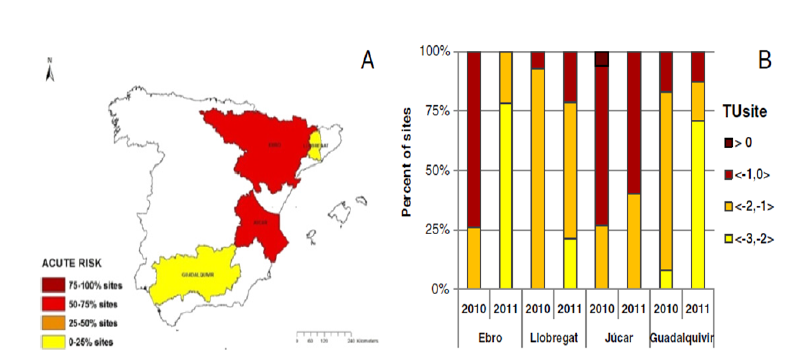
Figure 9:Impact of Pollution on fish, algae and invertebrates in four Iberian Rivers [31].

Case study south Leeds: Impact of effluent, untreated chemicals/pharmaceuticals from WWTP on ecosystem
Laura [35] conducted a study to find the presence and impacts of chemicals/pharmaceuticals excreted by human beings and mixed through untreated effluents from WWTP into the river ecosystem. The common Sources and pathways of human drugs in urban rivers are shown in Figure 10. The results are affected by temporal, spatial, dilution and distance variations from WWTP to the streams. Different sites exhibited the presence of various pharmaceuticals in different quantities during varying timings of day/months depending on the demography/ population, as shown in Figures 11 & 12 for the South Leeds catchment area [35].
Figure 10:Sources and pathways of human excreted pharmaceuticals in urban rivers [36].

Figure 11:Spatial Variations - human excreted pharmaceuticals in urban rivers [37].
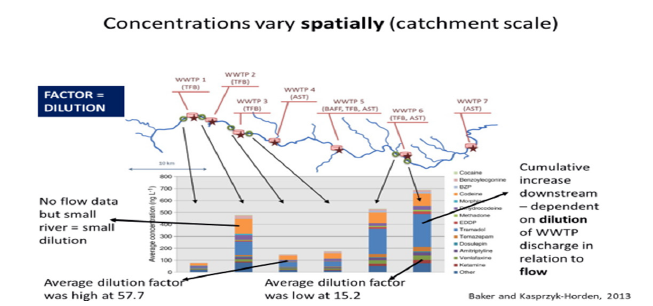
Figure 12:Temporal Variations - human excreted pharmaceuticals in urban rivers [37].

Case study-Ingbirchworth and scout dyke reservoirs, England
Nadir and Ahmed [38], in their study on Ingbirchworth Reservoir (a drinking water reservoir of Yorkshire water) and Scout Dyke Reservoir (a reservoir containing treated water from wastewater treatment plants to use as a compensatory water source for Don River), observed the nutrients and pollutants examined through water testing found exceeding the standard limits for drinking/ clean water (Tables 1 & 2) due to temporal/seasonal drainage, especially after the rainfall and fresh tillage/slurry/fertilisers’ application. The adjacent farmlands have been made part of the catchment-sensitive farming scheme falling near the drinking water reservoirs and concerted efforts have been made by the concerned departments and the farmers in maintaining buffer zones, nonapplication of slurry/fertilisers during rainy periods, keeping the stock under sheds and implementation of all other regulations. Still, the complete success of catchment-sensitive farming has yet to be achieved [38].
Table 1:Water Samples Test Results-Scout Dyke Compensatory Reservoir [38].

Table 2:Water Samples Test Results-Ingbirchworth Drinking Water Reservoir [38].

Conclusion and Recommendations
A. It is evident from the case studies above those pollutants,
nutrients, chemicals, micropollutants and pharmaceuticals are
present in all water streams. These pollution/contamination
sources are causing the worst impacts on the stream ecosystem,
from reduced abundance/richness to the ultimate depletion of
species/biodiversity, waterborne diseases and unsafe drinking
water.
B. The genetic modifications in species due to these
pollutants/chemicals result in impaired genetics/ reproduction
and reduced species’ colony formation/survival capabilities.
C. The catchment management practices, and filtration/
treatment methods have not been highly effective in
controlling/removing water contamination, necessitating the
full involvement of the public/ private sectors to reduce the
contamination along the streams.
D. It is recommended to control heavy modification in
all water bodies, stop the anthropogenic activities/human
interventions to the rivers’ ecosystems and prevent the mixing
of untreated sewage/ waste into water streams.
E. Our combined responsibility should focus on preserving
nature’s purest shape for future generations.
References
- Strayer DL, Dudgeon D (2010) Freshwater biodiversity conservation: recent progress and future challenges. J North Am Benthol Soc 29(1): 344-358.
- Rico A, Vanden Brink PJ, Leitner P, Graf W, Focks A (2016) The relative influence of chemical and non-chemical stressors on invertebrate communities: A case study in the Danube River. Sci Total Environ 571: 1370-1382.
- Malmqvist B, Rundle S (2002) Threats to the running water ecosystems of the world. Environ Conserv 29(2): 134-153.
- Brack W, Altenburger R, Schüürmann G, Krauss M, López HD (2015) The solution project: challenges and responses for present and future emerging pollutants in land and water resources management. Sci Total Environ 503-504: 22-31.
- Hering D, Carvalho L, Argillier C, Beklioglu M, Borja A, et al. (2015) Managing aquatic ecosystems and water resources under multiple stress-an introduction to the MARS project. Sci Total Environ 503-504: 10-21.
- Navarro-Ortega A, Acuña V, Bellin A, Burek P, Cassiani G, et al. (2015) Managing the effects of multiple stressors on aquatic ecosystems under water scarcity. The GLOBAQUA project. Sci Total Environ 503-504: 3-9.
- Berger E, Peter H, Kuemmerlena M, Moritz L, Ralf BS, et al. (2017) Water quality variables and pollution sources shaping stream macroinvertebrate communities. Sci Total Environ 587-588: 1-10.
- EEA (2015) The european environment-state and outlook 2015: Synthesis report. European Environment Agency, Copenhagen.
- Nadir HM, Ahmed A (2023) The critical review of the performance of the Eu water framework directive in improving the rivers’ water quality and the impediments in its implementation. Novel Research in Science 14(4): 1-7.
- UKGWF (2016) UK ground water forum on WFD-The future for Monitoring.
- Water Cycle (2020) National weather service jet stream max project.
- Edwards AC, Withers PJA (2008) Transport and delivery of suspended solids, nitrogen and phosphorus from various sources to freshwaters in the UK. Journal of Hydrology 350(3-4): 144-153.
- DEFRA (2007) The protection of waters against pollution from agriculture: consultation on diffuse sources in England.
- DEFRA (2009) Protecting our water, soil and air-a code of good agricultural practice for farmers, growers and land managers.
- Mesa LM (2014) Influence of riparian quality on macroinvertebrate assemblages in subtropical mountain streams. J Nat Hist 48(19-20): 1153-1167.
- Miserendino ML, Casaux R, Archangelsky M, Di Prinzio CY, Brand C, et al. (2011) Assessing land-use effects on water quality, in-stream habitat, riparian ecosystems and biodiversity in Patagonian northwest streams. Sci Total Environ 409(3): 612-624.
- Vannote RL, Minshall GW, Cummins KW, Sedell JR, Gushing CE (1980) The river continuum concept. Can J Fish Aquat Sci 37: 130-137.
- Quynh Lea Thi Phuong, Cuong Tu Hob, Thi Thuy Duong, Emma Rochelle-Newall, Dinh Kim Dang, et al. (2014) Nutrient budgets (N and P) for the Nui Coc reservoir catchment (North Vietnam). Agricultural Water Management 142: 152-161.
- Fierro P, Carlos B, Jaime T, Enrique H, Fernando PC, et al. (2017) Effects of local land-use on riparian vegetation, water quality, and the functional organisation of macroinvertebrate assemblages. Sci Total Environ 609: 724-734.
- Gonzalez E, Rochefort L, Boudreau S, Hugron S, Poulin M (2013) Can indicator species predict restoration outcomes early in the monitoring process? A case study with peatlands. Ecol Indic 32: 232-238.
- Smith Jim (2018) Jims’s Diary: Monitoring changes in habitat over time: Biological monitoring-Ouse and Adur Rivers Trust.
- Nadir HM, Carrivick J (2019) Impact of adjacent land use, infrastructure and urbanization on water quality in a river from headwater to downstream. International Journal of Advances in Science, Engineering and Technology (IJASEAT) 7(3):16-23.
- Galloway Gerry (2004) USA: Flood Management-Mississippi River integrated flood management case study published by WMO/GWP Associated Programme on Flood Management (APFM).
- USACE (2016) US Army Corps of Engineers.
- Perri Eward B (1998) Innovative methods for levee rehabilitation published vide USACE technical report REMR-GT-26.
- Wang R, Kalin L, Kuang W, Tian H (2014) Individual and combined effects of land use/cover and climate change on Wolf Bay watershed streamflow in southern Alabama. Hydrol Process 28(22): 5530-5546.
- Matthew S, Samuel J Bentley (2014) Sediment capture in flood plains of the Mississippi River: A case study in Cat Island National Wildlife Refuge, Louisiana. Sediment Dynamics from the Summit to the Sea, Proceedings of a symposium held in New Orleans, Louisiana, USA, 11–14 December 2014) (IAHS Publ 367: 442-446.
- Buisson L, Thuiller W, Lek S, Limp P, Grenouillet G (2008) Climate change hastens the turnover of stream fish assemblages. Global Change Biol 14(10): 2232-2248.
- USACE (2008) US Army Corps of Engineers.
- EU WFD (2000) European Parliament and Council, 2000. Directive 2000/60/EC of the European parliament and of the Council of 23 October 2000 establishing a framework for Community action in the field of water policy. Official Journal L 327: 1-73.
- Kuzmanovic M, Julio C Lopez-Doval, Nuria De Castro-Catala, Helena Guasch, Mira Petrovic, et al. (2016) Ecotoxicological risk assessment of chemical pollution in four Iberian river basins and its relationship with the aquatic macroinvertebrate community status. Sci Total Environ 540: 324-333.
- Feld CK, De Bello F, Dolédec S (2014) Biodiversity of traits and species both show weak responses to hydromorphological alteration in lowland river macroinvertebrates. Fresh W Biol 59(2): 233-248.
- Liess M, Vonder Ohe PC (2005) Analysing effects of pesticides on invertebrate communities in streams. Environ Toxicol Chem 24(4): 954-965.
- Schäfer RB, Pettigrove V, Rose G, Allinson G, Wightwick A, et al. (2011) The effects of pesticides were monitored with three sampling methods in 24 sites on macroinvertebrates and microorganisms. Environ Sci Technol 45(4): 1665-1672.
- Carter L (2019) Emerging contaminants in urban rivers, Lecture in GEOG5530: River basin management for water quality, University of Leeds.
- thermofisher.com/uk/en/home/industrial/environmental/environmental/learning-center/contaminant-analysis-information/emerging-contaminants-analysis.html#sources
- Baker DR, Kasprzyk H (2013) Spatial and temporal occurrence of pharmaceuticals and illicit drugs in the aqueous environment and during wastewater treatment: new developments. Sci Total Environ 454-455: 442-456.
- Nadir HM, Ahmed A (2021) Impact of nitrate vulnerable zones and catchment sensitive farming on water quality in UK: Case study of Ingbirchworth and scout dyke reservoirs. Research & Development in Material Science 14(5): 1610-1619.
© 2023 Hafiz Muhammad Nadir. This is an open access article distributed under the terms of the Creative Commons Attribution License , which permits unrestricted use, distribution, and build upon your work non-commercially.
 a Creative Commons Attribution 4.0 International License. Based on a work at www.crimsonpublishers.com.
Best viewed in
a Creative Commons Attribution 4.0 International License. Based on a work at www.crimsonpublishers.com.
Best viewed in 







.jpg)






























 Editorial Board Registrations
Editorial Board Registrations Submit your Article
Submit your Article Refer a Friend
Refer a Friend Advertise With Us
Advertise With Us
.jpg)






.jpg)














.bmp)
.jpg)
.png)
.jpg)










.jpg)






.png)

.png)



.png)






